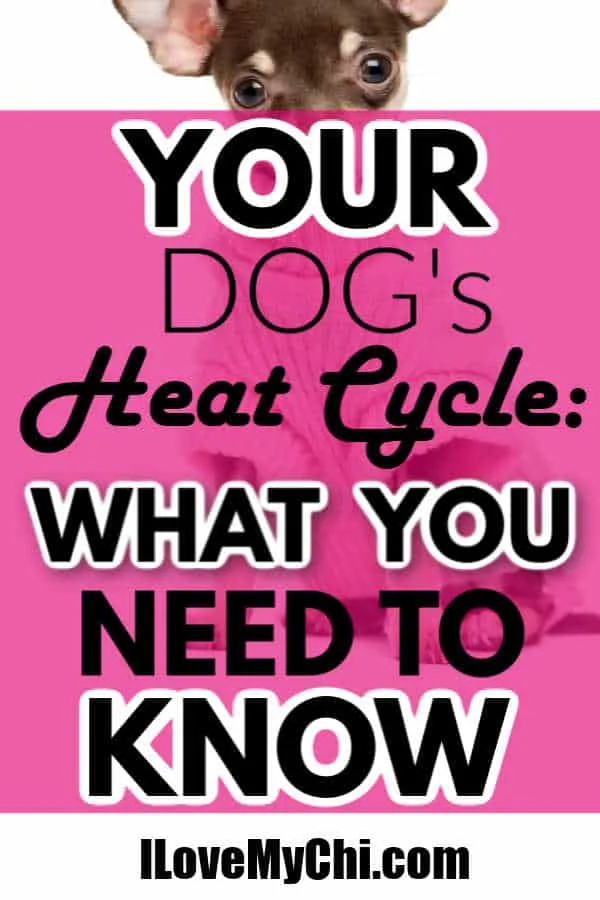
Oestrus, also known as the “heat cycle”, is the process a female dog’s body goes through where her body prepares to become pregnant and she becomes receptive to breeding.
All breeds of dogs experience oestrus, however, smaller breeds experience it more frequently than larger breeds. This means that Chihuahuas will deal with more heat cycles than other breeds.
To help your dog remain physically healthy, and help her through the process mentally and emotionally, it is a good idea to educate yourself about the heat cycle.
Let’s discuss what you need to know about it to pet parent like a pro:
What Are The Symptoms When A Dog Goes Into Heat?
There are three stages in the heat cycle. Banfield Pet Hospital describes them as follows:
1. Proestrus. In this stage, your dog’s vulva will become swollen, she will display bloody discharge, she will urinate more, she will pay more attention to her hind end, she will hold her tail down, and she may groom her hind end more frequently.
Normally, these symptoms would be a cause for concern; however, during a heat cycle, this is all normal.
She will not want to breed during this stage.
As a Chihuahua owner, you may not think this is possible, but during this stage, she may become even more clingy to you than usual!
2. Estrus. This stage is when she will be fertile and ready to breed, and this is the stage that she is most likely to become pregnant.
VCA Hospital states that sperm can survive for a week in her reproductive organs, increasing the likelihood of pregnancy.
The discharge will change from bloody to brownish or clear in color. When the discharge becomes clear and watery she is ovulating.
You may observe a behavior known as “flagging”; she will hold her hind end higher, and hold her tail to the side in the presence of male dogs.
If you are planning to breed her, schedule an appointment with her veterinarian to ensure she is healthy and able to be bred. We recommend waiting until she is at least 2 years of age.
She will emit pheromones that will capture the attention of male dogs, and make female dogs behave aggressively towards her.
Due to the increased risk of conflict, and her willingness to breed, it is important she is kept away from other dogs during this period to prevent unplanned pregnancy and dog fights. She should be monitored at all times outdoors as male dogs will travel to find her.
During this stage of oestrus, your dog is most susceptible to a uterine infection called pyometra. If you observe pus coming from her vulva, or she seems ill, immediately schedule a veterinary examination, as this condition is life-threatening.
If your dog is spayed, she will not be at risk for this infection.
3. Diestrus. This is the last stage of oestrus. Your dog will lose interest in mating, her vulva will gradually return to normal size, and discharge should stop.
Some dogs may display symptoms of pregnancy during this stage. Be sure to schedule a veterinary appointment if your dog displays symptoms of pregnancy.
Dogs may sometimes display symptoms even though they are not pregnant, known as false pregnancy. Veterinary care is necessary if the dog is pregnant or experiencing false pregnancy.
When Does The First Heat Cycle Start?

Dogs go into heat when they reach puberty, similarly to human teenage girls, except that on average, most dogs reach puberty around six months of age. According to VCA Hospitals, smaller dogs tend to reach puberty more quickly than larger breeds.
Chihuahua parents should be on the lookout for symptoms of heat around four months of age according to the American Kennel Club.
How Often Do Dogs Go Into Heat?
According to the American Kennel Club, small breeds usually have approximately three or four heat cycles per year. Similar to how human monthly cycles vary by individual, different dogs will experience different lengths of cycles and different amounts of bleeding and discharge during their cycles.
How Long Does a Heat Cycle Last?
According to the American Kennel Club, heat cycles often last two to four weeks.
Similarly to human adolescent girls, heat cycles will not become regular immediately. Some dogs will not have a regular heat cycle until they have had them for over a year.
If you have a puppy who you do not plan to spay, be sure to keep notes on when her heat cycle begins and ends, as well as any symptoms she experiences, to share with your veterinarian.
These notes will be helpful to plan a spay procedure or to help your veterinarian advise you when your dog is mature enough and healthy enough, to be bred if you are planning on breeding.
How Long Does A Dog In Heat Bleed?
The heat cycle lasts about two to four weeks, and when your dog’s vulva enlarges, she will begin to bleed. In the final stage of the heat cycle, diestrus, the vulva will begin to decrease in size and the bleeding will stop.
Most dogs will bleed for approximately two weeks until they reach diestrus, but this will vary by dog. Like human menstrual cycles, every dog will bleed for a unique amount of time, and in a unique amount, based upon her individual body and cycle.
If you notice non-stop or excessive bleeding, discharge that looks like pus, or observe what looks like bloody urine, get your dog to the vet as soon as possible.
How Can I Comfort A Dog In Heat?

The heat cycle brings on hormonal changes, which may result in your dog experiencing mood swings, and feeling nervous or anxious.
She will be tired because her body is having to work extra hard. She is probably uncomfortable because she feels like she is having accidents, and she might need to urinate more frequently than normal. Since she probably does not feel as great as usual, her appetite might suffer a bit as well.
Stephen from the “Relax My Dog” YouTube channel discusses how he cares for his Chihuahua, Ellie, during her heat cycle in his video, How to Calm a Dog in Heat. To keep your dog comfortable, try some of Stephen’s tips:
- Offer extra snuggles and make sure her favorite bed and blankets are clean and available for her.
- Avoid stressful situations and allow her to rest if she is tired.
- Keep her sequestered indoors, on a leash outdoors, or if she wants to be off-leash this should only occur under supervision in a fenced area, to avoid harassment from unwanted suitors or aggression from other females.
- If she will not eat, it can be tempting to offer lots of different foods. However, this should be avoided, as she will experience digestive issues. If she refuses to eat her regular food, offer plain baked chicken and plain steamed white rice.
- Purchase doggy panties or doggy diapers to prevent messes from accumulating around the house. Do not use scented pads or liners, as they may irritate her skin. Be sure to take it off every so often and clean her to prevent infection. Let her go outside and run around with the diaper or panties off to let her private parts get some fresh air to prevent odor and bacteria from accumulating.
- Arrange for regular preventive veterinary care, or emergency care if she experiences a difficult cycle, to keep her healthy and comfortable.
- Your dog will experience mood swings; be patient with her.
Is My Dog In Pain When She Is In Heat?
We cannot know for sure if dogs experience pain while in heat, but since it is common for human women to experience pain during their monthly cycles, it is certainly a possibility that dogs experience pain as well.
Sometimes you might observe your dog whining excessively during her heat cycle, which may make you think that she is in pain. She could be in pain or uncomfortable, or it could be as a result of the hormones raging through her body, making her upset and fussy.
When in doubt, be sure to schedule a veterinary appointment.
How Do I Know When My Dog Has Finished Her Heat Cycle?
When her vulva begins to reduce in size, she is no longer flagging, her temperament returns to her normal demeanor, and there is very minor or no discharge present, the heat cycle has ended.
Does My Dog Have To Have A Heat Cycle Before She is Spayed?
You might have heard from some dog owners that it is good for a dog to experience one heat cycle before she is spayed, or to have one litter of puppies before she is spayed.
The good news is those are myths! Most veterinarians actually recommend spaying small breed dogs before they experience a heat cycle.
If you are unsure, consult with your veterinarian to make a health plan for your dog.
Read this article by the ASPCA for more myths about spaying and neutering.
Should I Spay My Dog?

As you have read above, the heat cycle is not an entirely pleasant experience. You can save your dog from having to go through that by spaying her before she goes into heat.
Your veterinarian will advise you on when the best time to spay her would be.
According to The ASPCA, there are many benefits to your dog being spayed, such as:
- Spaying increases life span; uterine infections, cancers, tumors, and breast tumors, may be prevented by spaying. In 50% of dogs, these conditions are fatal.
- Every heat your dog experiences, increases her likelihood of certain diseases.
- Spaying is less expensive than raising a litter of puppies.
- Spaying your dog makes her less appealing to dog thieves, who may plan to steal a dog to breed for profit.
The Ethical Concerns of Breeding Dogs
The ethical treatment of breeding dogs should be of great concern to Chihuahua owners, as this breed is very popular, frequently making female Chihuahuas the victims of unethical breeding practices.
For information on ethical breeding practices, refer to this article by The American Kennel Club.
Dogs who are victims of unethical breeding are often subject to:
- Dirty and uncomfortable living conditions; they are not kept in a home and raised as part of a family.
- They are often kept in outdoor structures like barns or rabbit cages.
- They rarely experience socialization or love; they may never be cuddled or petted.
- Unethical breeders will spend the absolute minimum on the care of their dogs, and charge very high prices for their puppies, to increase their profits.
- The dogs receive minimal veterinary care, though most often, they receive none at all.
- Female dogs are bred every heat cycle or as often as possible; even though it is not healthy for dogs to be pregnant and give birth this frequently.
- Female dogs may be abandoned or killed if they are no longer able to become pregnant.
- Male dogs may also be abandoned or killed if they are no longer able to sire litters.
If you want to get involved with helping Chihuahuas, and other dogs, who have been victims of unethical breeding practices, here are resources to help you find a place to start becoming part of the solution:
- The National Mill Dog Rescue rescues animals from puppy mills. You could find your next best friend there!
- The ASPCA discusses puppy mills in this article.
- The ASPCA discusses legislation that needs to change to protect breeding dogs in this article.
Summary
The smaller the breed of dog, the more heat cycles they will have.
Heat cycles may last two to four weeks, and during this time, your dog is susceptible to uterine infections, harassment from male dogs, and aggression from female dogs.
Spaying avoids the heat cycle from occurring at all and increases your dog’s life span by preventing her from being susceptible to fatal medical conditions.
Schedule an appointment with a veterinarian to discuss how to keep your female chihuahua healthy.


Paula Simons
DVM
This article has been reviewed, fact-checked, and approved by Dr. Paula Simons DVM. You can read more about her on our About page.
PIN FOR LATER:

